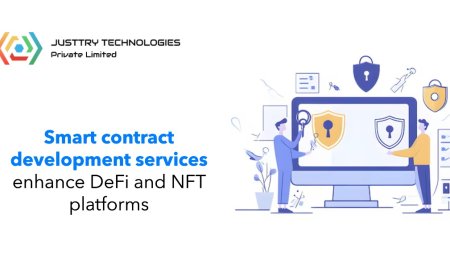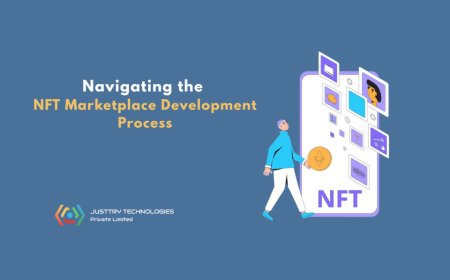From Concept to Launch: Complete AI Chatbot Development Services
This blog explores the end-to-end process of AI chatbot development—from identifying business goals and designing conversational flows to training AI models and integrating chatbots across digital channels. It highlights the importance of personalized interactions, automation, and scalability, showing how complete AI chatbot development services help businesses enhance customer engagement, reduce operational costs, and stay competitive in 2025’s digital-first landscape.

In the rapidly changing digital world, companies are always challenged to enhance customer interaction, speed up response times, and provide individualized service. AI chatbot development services are useful in this situation. An AI chatbot that is well-developed can serve as your virtual assistant around the clock, improve client happiness, and expedite processes.
This comprehensive guide walks you through everything you need to know about complete AI chatbot development servicesfrom concept to launch.
Why Businesses Are Investing in AI Chatbots
AI-powered chatbots are no longer optionalthey're essential. Heres why:
- 24/7 Customer Support: Never miss a lead or customer query.
- Instant Responses: Improve customer satisfaction with zero wait time.
- Cost Efficiency: Save costs on hiring and managing large support teams.
- Data-Driven Insights: Learn from user interactions to enhance services.
- Scalability: Handle thousands of conversations simultaneously.
Whether youre a startup or a large enterprise, investing in AI chatbot development services gives your business a competitive edge.
Step 1: Understanding the Project Vision
The first and most crucial step in chatbot development is defining the objective. What problem should the chatbot solve? Will it assist in lead generation, support, sales, or bookings?
Key questions to ask:
- Who is your target audience?
- What kind of queries will users ask?
- Which platform will the chatbot be deployed on (web, mobile, WhatsApp, etc.)?
A solid understanding of your use case helps define the chatbots architecture, tone, and conversational flow.
Step 2: Choosing the Right Technology Stack
A successful AI chatbot relies on powerful, scalable technologies. Your development partner should help you choose the right stack based on:
- NLP (Natural Language Processing): Google Dialogflow, Microsoft Bot Framework, Rasa, OpenAI.
- Programming Languages: Python, JavaScript, Node.js.
- Database: MongoDB, Firebase, MySQL.
- Hosting & APIs: AWS, Azure, or custom cloud infrastructure.
The choice depends on your business requirements, scalability goals, and integration needs.
Step 3: Designing the Conversational Flow
This phase focuses on conversation designmapping out how the chatbot will interact with users.
Elements involved:
- User personas and intent mapping
- Dialogue scripting and fallback scenarios
- Tone of voice (formal, friendly, humorous, etc.)
- Multi-language support (if required)
A well-structured conversation improves user engagement and satisfaction. It's important to simulate real-world queries and responses as part of the design phase.
Step 4: AI Model Training and Testing
This is where your chatbot becomes intelligent.
- Intent recognition training: Train the bot to understand user queries using AI models.
- Entity extraction: Recognize dates, names, locations, and other context-specific information.
- Machine learning refinement: The bot continuously learns and improves over time.
Rigorous testing is done to cover:
- Common queries and responses
- Edge cases and fallbacks
- Voice recognition (if using voice bots)
- Multi-turn conversations
Step 5: Integration with Platforms and Tools
Your chatbot should seamlessly integrate with your existing ecosystem. Common integrations include:
- CRM systems like Salesforce, Zoho, and HubSpot
- Live chat support tools like Zendesk, Intercom
- Social messaging apps like WhatsApp, Facebook Messenger, and Instagram
- Payment gateways, eCommerce platforms, and more
The goal is to automate workflows and deliver a connected experience to users.
Step 6: Launch and Continuous Improvement
Once your chatbot is tested and integrated, it's ready to go live. But thats not the end.
Post-launch steps include:
- Real-time performance monitoring
- User behavior analytics
- Training updates based on new data
- Feature upgrades and enhancements
AI chatbots thrive on data. The more your chatbot interacts, the more intelligent and contextual it becomes over time.
Industries That Benefit the Most from AI Chatbot Development Services
While almost any business can benefit from chatbots, here are a few industries leading the charge:
- E-commerce: Product recommendations, order tracking, customer support
- Healthcare: Appointment scheduling, symptom checking, patient engagement
- Finance: Account inquiries, transaction alerts, loan processing
- Travel: Bookings, itineraries, real-time flight updates
- Education: Course recommendations, student support, automated assessments
If you want to build AI chatbot solutions that are tailored to your industry, working with a domain-specific team is essential.
Choosing the Right AI Chatbot Development Partner
The success of your chatbot depends heavily on the team behind it. When selecting a service provider, look for:
- Experience in AI and NLP technologies
- Customization and scalability options
- Security and data privacy measures
- Post-launch support and maintenance
- Case studies and proven results
An expert mobile app development company offering AI chatbot development can help translate your business goals into intelligent, user-friendly chatbot solutions.
Future Trends in AI Chatbot Development
Looking ahead, AI chatbots are expected to become more personalized and voice-enabled, with advancements in:
- Generative AI development for human-like responses
- Emotion detection and sentiment analysis
- Voice-first interactions with NLP
- Integration with IoT devices
- Hyper-personalized marketing
Now is the perfect time to create AI chatbot solutions that are future-ready and aligned with customer expectations.


























